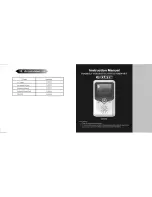
GB
16
time after changing the saw blade.
7.3 Fitting the saw blade guard (Fig. 4)
Mount the saw blade guard (2) on the splitter (5)
and align.
Insert the knurled screw (18) through the hole in
the saw blade guard (2) and in the splitter (5)
and secure it with the nut.
To remove the saw blade guard, proceed in
reverse order.
7.4 Replacing the table insert (Fig. 4)
Caution! Pull out the power plug.
Remove the 6 screws (23).
Take off the saw blade guard (2) (see 7.3).
Lift the worn table insert (6) up and out.
Fit a new table insert in reverse order.
8.0 Using the saw
8.1 On/Off switch (Fig. 1)
The saw can be switched on by pressing the
green pushbutton Å.
The red pushbutton Ä has to be pressed to
switch off the saw.
8.2 Parallel stop
8.2.1 Stop height (Fig. 7/8)
The parallel stop (7) supplied with the bench-
type circular saw has two different guide faces.
For thick material you must use the stop rail (25)
as shown in Fig. 7, for thin material you must use
the stop rail as shown in Fig. 8.
To change the height of the stop, slacken the two
knurled screws (16) and pull the stop rail off the
carrier rail.
Turn the stop rail (25) 90° to the left or the right,
depending on the required height of the stop,
and plug in back on the carrier rail (26).
Re-tighten the knurled screws (16).
8.2.2. Stop length (Fig. 7/8)
To prevent the workpiece becoming jammed,
always slide the stop rail (25) to the front edge of
the table (1) and fix it in place with the two
knurled screws (16) (see 8.2.1).
8.2.3 Cutting width (Fig. 8)
The parallel stop (7) has to be used when
making longitudinal cuts in wooden workpieces.
Slide the parallel stop (7) to the right or left side
of the saw table (1).
The parallel stop (7) can be set to the required
dimension with the help of the scale (b) engraved
on the saw table (1).
Tighten the two thumb screws (12) in order to fix
the parallel stop (7).
8.3 Adjusting the angle (Fig. 9/10)
Slacken the star-grip screws (16).
You can now adjust the blade (4) to the required
angle (see scale (13)) by sliding the two star-grip
screws (16).
Re-tighten the star-grip screws (16).
9. Sawing operations
After each new adjustment it is advisable to
carry out a trial cut in order to check the set
dimensions.
After switching on the saw, wait for the blade to
reach its maximum speed of rotation before
commencing with the cut.
Secure long workpieces against falling off at the
end of the cut (e.g. with a roller stand etc.)
Take extra care when starting the cut!
9.1 Cutting narrow workpieces
(width less than 120 mm) (Fig. 11)
Adjust the parallel stop (7) to the width of
workpiece you require.
Feed in the workpiece with two hands. Always
use the push stick (3) in the area of the saw
blade (4).
(A push stick is supplied with the saw!)
Always push the workpiece through to the end of
the splitter (5).
Caution! With short workpieces, use the push
stick from the beginning.
9.2 Cutting extremely narrow workpieces
(width less than 30 mm) (Fig. 12)
Adjust the parallel stop (7) to the width of
workpiece you require.
Use the push block (d) to press the workpiece
against the stop rail (25) and push the workpiece
AnleitungTK 600_1 22.07.2005 14:42 Uhr Seite 16
















































